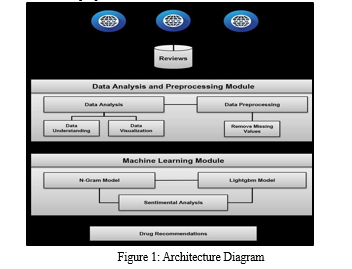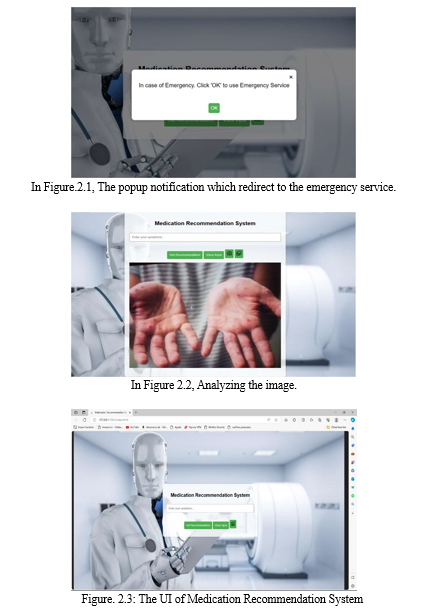Ijraset Journal For Research in Applied Science and Engineering Technology
- Home / Ijraset
- On This Page
- Abstract
- Introduction
- Conclusion
- References
- Copyright
Medication Recommendation System Using AI
Authors: Rajinikanth Mohanty, Rangu Sriram Chandra, Marakala Manoj, Thakkali Murali, Yeabtsega Behailu
DOI Link: https://doi.org/10.22214/ijraset.2024.61642
Certificate: View Certificate
Abstract
In an era marked by the convergence of personal and technical facets of life, the need for a versatile and intelligent companion becomes increasingly apparent. This project introduces the development of a novel Chatbot, aptly named the \"Personal and Technical Companion,\" designed to seamlessly integrate into users\' lives by offering personalized support and technical assistance. The Chatbot employs state-of-the-art Natural Language Processing (NLP) techniques to engage users in natural language conversations, providing a unique blend of personal and technical guidance. The system architecture encompasses a user-friendly interface, a robust NLP engine for intent recognition, a dynamic backend server handling logic and personalization, and integration with external services to enrich the user experience. Simultaneously, it serves as a technical companion by offering code assistance, troubleshooting guidance, and recommending relevant learning resources. Implementation leverages cutting-edge technologies, including Python for backend logic, Flask for the server, TensorFlow for NLP processing, and HTML/CSS for the user interface. The project follows an Agile methodology with iterative development cycles, allowing for continuous refinement and enhancement of features. Challenges such as NLP accuracy and user personalization are addressed through ongoing training and machine learning. The presentation of this project encompasses a comprehensive overview of the system architecture, key features, partial implementation details, live demonstrations, challenges faced during development, and future work. Additionally, a user feedback questionnaire is employed to gather valuable insights into the usability, effectiveness, personalization, and technical assistance provided by the \"Personal and Technical Companion.\" This project represents a significant step towards creating an intelligent assistant that harmoniously blends into users\' lives, offering a holistic approach to personal and technical support in a dynamic and ever-evolving digital.
Introduction
I. INTRODUCTION
The motivation behind this project lies in the recognition that individuals today grapple with a myriad of personal and technical challenges, from managing personal preferences and moods to seeking assistance with coding and troubleshooting technical issues. The "Personal and Technical Companion" is conceptualized as a multifaceted solution that addresses these challenges, providing an intelligent interface for users to interact with technology in a more intuitive and personalized manner. The project focuses on employing sophisticated Natural Language Processing (NLP) techniques to empower the Chatbot with conversational capabilities. This not only facilitates seamless communication but also enables the system to understand the user's intent, moods, and preferences. The architecture of the Chatbot encompasses a user-friendly interface, a robust NLP engine, a dynamic backend server for logic and personalization, and integration with external services to enhance the user experience. This introduction sets the stage for exploring the innovative features that define the "Personal and Technical Companion." The project delves into the development process, the challenges encountered, and the methodologies employed to create a Chatbot that stands at the intersection of personal and technical realms. As technology continues to evolve, this project envisions a Chatbot that transcends traditional boundaries, serving as a true companion in the multifaceted journey of the modern individual.
II. LITERATURE SURVEY
The literature survey for the Medication Recommendation System project encompasses a thorough examination of existing research and scholarly works to gain insights into the evolving landscape of AI-driven healthcare solutions. Commencing with an overview of foundational concepts, the survey delves into established models and algorithms, including collaborative and content-based filtering, offering a comprehensive understanding of their applications and limitations. Exploration of diverse data sources, such as electronic health records, and associated preprocessing techniques reveals the complexities involved in enhancing data quality. The survey scrutinizes the features crucial for effective recommendations, spanning patient demographics, medical history, and diagnosis information.
Machine learning and deep learning techniques take center stage, showcasing their roles in tailoring personalized and accurate medication suggestions. Evaluation metrics like accuracy and precision are reviewed, alongside considerations for user interface design and user experience. Ethical dimensions, including privacy concerns and bias mitigation, are explored, highlighting the ethical considerations integral to system development. Real-world deployments and case studies provide valuable insights into the practical implications of these systems in healthcare settings. The literature survey concludes by identifying future trends, challenges, and gaps in research, setting the stage for the proposed methodology to contribute meaningfully to the field. Privacy concerns and ethical considerations in handling sensitive patient data emerge as recurrent themes, emphasizing the need for transparent and secure system architectures. Real-world case studies provide concrete examples of successful deployments, illustrating the impact on patient outcomes and healthcare workflows. The survey includes a comparative analysis of AI-driven approaches against traditional methods, elucidating the strengths and weaknesses of each paradigm. As the survey unfolds, it anticipates future trends, such as explainable AI and federated learning, and addresses ongoing challenges, positioning the Medication Recommendation System project within the dynamic trajectory of this field. In conclusion, the literature survey not only serves as a compass for understanding the current state-of-the-art but also as a foundation for propelling the project into unexplored territories, contributing to the advancement of AI in healthcare.
III. PROPOSED METHODOLOGY
The proposed methodology for the Medication Recommendation System project involves a systematic approach to leverage Artificial Intelligence for personalized and accurate medication suggestions. Here is a concise overview: Clearly define the objectives of the Medication Recommendation System, specifying the target audience, scope of medications covered, and desired outcomes. Gather diverse and representative datasets, including electronic health records, patient demographics, and medication histories. Integrate data from various sources to create a comprehensive dataset for training and testing. Implement preprocessing techniques to handle missing values, outliers, and ensure data consistency. Normalize numerical features and encode categorical variables for uniformity. Choose an appropriate AI model based on the project requirements. Consider a hybrid approach, incorporating both collaborative filtering and content based filtering for a comprehensive recommendation system. Split the dataset into training and testing sets. Develop an intuitive and user-friendly interface for healthcare professionals and patients to interact with the system. Prioritize a design that facilitates seamless integration into existing clinical workflows. Implement robust measures to address ethical concerns, ensuring patient privacy, mitigating bias, and promoting fairness in the recommendation process. Deploy the system in a controlled real-world environment, collaborating with healthcare professionals to assess its effectiveness, user acceptance, and impact on patient outcomes. Establish mechanisms for continuous monitoring of system performance. Regularly update the model with new data and iterate based on user feedback to improve recommendations over time. Document the entire methodology, including data sources, preprocessing steps, model architecture, and deployment procedures. Provide clear instructions for system maintenance and updates. Conduct user training sessions for healthcare professionals to familiarize them with the system, emphasizing the benefits and proper utilization of medication recommendations.

In Figure.1, The Architecture Diagram for the Medication Recommendation System delineates the structural components and their interactions in designing an efficient and scalable system. At the core is a central module representing the Medication Recommendation Engine, responsible for orchestrating the entire process. This engine interacts with three primary subsystems: the Patient Data Management subsystem, which handles the collection and validation of patient information; the Medical Analysis subsystem, which encompasses symptom analysis, diagnostic tools, and health history checks; and the Medication Knowledge Base subsystem, responsible for storing a comprehensive database of medications, including dosages, interactions, and side effects.
IV. IMPLEMENTATION
A. App Components


B. Algorithm
Designing the algorithm for a Medication Recommendation System involves combining various techniques to provide accurate and personalized recommendations. Here's a high-level algorithmic outline for such a system:
- Data Collection: Collect patient data from diverse sources, including electronic health records (EHR), demographics, and medication histories.
- Data Preprocessing: Clean and preprocess the data to handle missing values, outliers, and ensure consistency.
- Feature Engineering: Extract relevant features from the data, such as patient demographics,medical history, diagnosis, and treatment outcomes.
- Model Selection: Choose an appropriate model based on the nature of the problem.Hybrid models combining collaborative filtering, content-based filtering, and potentially deep learning can be effective.
- Training the Model: Train the selected model using historical patient data. This involves optimizing model parameters to achieve the best performance.
- Validation: Validate the model on a separate dataset to ensure its generalization and performance in real-world scenarios.
- Recommendation Generation: Given a new patient, input their relevant data into the trained model to generate personalized medication recommendations.
- User Interface Integration: Integrate the recommendation system into a user-friendly interface for healthcare professionals to input patient data and view recommendations.
- Feedback Collection: Allow healthcare professionals to provide feedback on the recommendations to improve the system over time.
- Continuous Monitoring: Implement continuous monitoring mechanisms to track system performance, user interactions, and potential issues.
- Documentation: Document the entire algorithm, including data sources, preprocessing steps, model architecture, and deployment procedures.
- User Training and Support: Provide training and support for healthcare professionals to effectively use and interpret the recommendations. This algorithmic outline provides a structured approach for developing a Medication Recommendation System. The specifics of each step can be tailored based on the characteristics of the healthcare data, the chosen model, and the project's goals.
Conclusion
Expanding the scope of the Medication Recommendation System (MRS) involves recognizing its potential impact on various facets of the healthcare ecosystem. Beyond individual patient care, the system can contribute to population health management by identifying patterns in medication effectiveness and adverse reactions. This data-driven approach enables healthcare providers and policymakers to make informed decisions for public health initiatives. Furthermore, the MRS can be integrated into electronic health record systems, fostering seamless communication between healthcare professionals and ensuring a holistic view of a patient\'s medical history. The project\'s scalability is another crucial aspect, as it can be adapted to different medical specialties and extended to address chronic conditions, mental health, and preventive care. Collaboration with pharmaceutical companies and research institutions could enhance the MRS by incorporating the latest advancements in drug development and treatment modalities, thus keeping the system dynamic and aligned with evolving medical knowledge. Emphasizing interoperability standards will facilitate integration with existing healthcare infrastructures, promoting widespread adoption and maximizing the system\'s positive impact across diverse healthcare settings. In essence, the Medication Recommendation System not only revolutionizes individualized patient care but also holds the potential to reshape healthcare practices on a broader scale, fostering a more efficient, data-driven, and interconnected healthcare ecosystem.
References
[1] \"Deep Learning\" by Ian Goodfellow, Yoshua Bengio, and Aaron Courville. [2] \"Hands-On Machine Learning with Scikit-Learn, Keras, and TensorFlow\" by Aurélien Géron. [3] Online Resources: Tensor Flow and PyTorch documentation for implementing deep learning models. [4] Online courses on platforms like Coursera, edX, or Udacity. [5] \"Computer Vision: Algorithms and Applications\" by Richard Szeliski. [6] \"Learning OpenCV 4\" by Adrian Kaehler and Gary Bradski. [7] \"Database Systems: The Complete Book\" by Hector Garcia-Molina, Jeffrey D. Ullman, Jennifer Widom. [8] \"Flask Web Development\" by Miguel Grinberg. [9] \"Fullstack Open\" - a free online course covering React, Node.js, and GraphQ. [10] \"Clean Architecture: A Craftsman\'s Guide to Software Structure and Design\" by Robert C. Martin. [11] \"AI and Machine Learning for Coders\" by Laurence Moroney (includes an ethical AI section).
Copyright
Copyright © 2024 Rajinikanth Mohanty, Rangu Sriram Chandra, Marakala Manoj, Thakkali Murali, Yeabtsega Behailu. This is an open access article distributed under the Creative Commons Attribution License, which permits unrestricted use, distribution, and reproduction in any medium, provided the original work is properly cited.

Download Paper
Paper Id : IJRASET61642
Publish Date : 2024-05-05
ISSN : 2321-9653
Publisher Name : IJRASET
DOI Link : Click Here
 Submit Paper Online
Submit Paper Online

